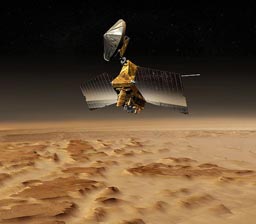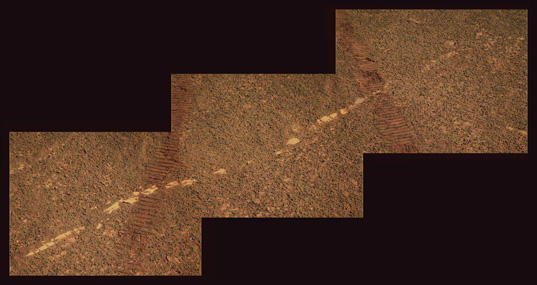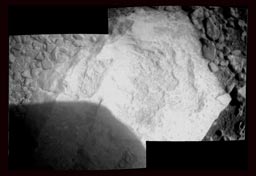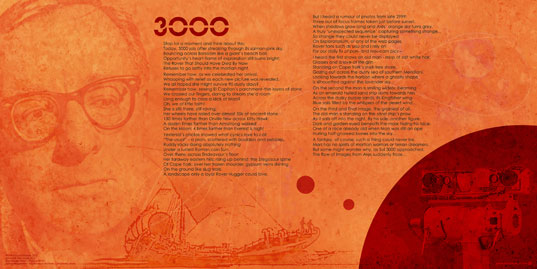A.J.S. Rayl • Jul 04, 2012
Mars Exploration Rovers Update: Opportunity Digs Cape York, Roves to New Milestone
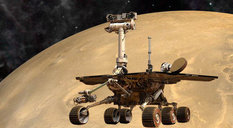
Mars Exploration Rover
NASA / JPL-Caltech / Maas Digital
Even robots deserve a break once in a while, and when the Mars Odyssey orbiter went into safe mode in June, Opportunity got the chance to hang out and leisurely take in her surroundings at the Red Planet, while the Mars Exploration Rover (MER) mission downshifted into lower gear.
Odyssey has worked at Mars longer than any other mission in history and is the Mars Exploration Rovers' main data link. While the Odyssey team successfully managed to bring their spacecraft out of safe mode in 9 days, full recovery required another 10 days. That meant the communication and data sending and retrieving opportunities with the rover were limited, so what Opportunity could get accomplished was limited.
Opportunity made the best of it, true to her MER nature, and spent time snapping dozens of images with her stereo panoramic camera (Pancam), and taking other measurements and close-up images of targets chosen by the scientists. And even before Odyssey was back in service, the rover that likes to rove roved on.
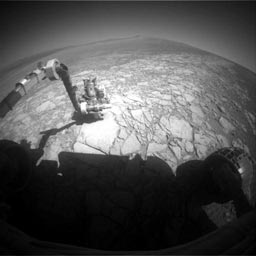
Opportunity at Grasberg
As June turns to July, Opportunity is checking out Grasberg, a slab of rock on the northern end of Cape York. Over the June 30 – July 1 weekend, the rover used her Rock Abrasion Tool (RAT) to brush off its surface and is now taking a closer look at it with her Alpha Particle X-ray Spectrometer (APXS).NASA/JPL-Caltech/Cornell/S. Atkinson
"It was a good month, but a slow month," summed up Matt Keuneke, a MER mission manager at the Jet Propulsion Laboratory (JPL), the NASA center where Opportunity and her twin Spirit – and new rover, Curiosity – were "born" and the home of their mission control.
Now positioned along the rim of Endeavour Crater at the northern edge of Cape York, Opportunity is digging in to a slab of rock, as it leads the MER mission to another milestone on what has become an extraordinary eight-and-a-half year expedition around Meridiani Planum – its 3000th sol of exploration, on July 2nd.
Spring is in full "bloom" in Mars' southern hemisphere and during the last several weeks the season has continued to stir up winds. A few strong gusts found their way to whisking off more and more of the accumulated dust on Opportunity's solar arrays.
"The good news is we've had some major cleaning and the power is way up," said Steve Squyres, principal investigator for rover science, of Cornell University. Opportunity is producing upwards of 550 watt-hours, more than half the 950 watt-hour power it had the day it fired up the engines, so to speak, after landing in 2004. "We're in great shape power-wise," he said.
The boost in energy was, of course, most welcome, especially since the rover had just emerged from the Martian winter when levels drop to often dangerously low levels. "The dust cleaning was the big news of the month," said Julie Townsend, rover planner. "The cleaning events are something we've been waiting for, hoping for, so it was a relief to see it finally happen," Keuneke added.
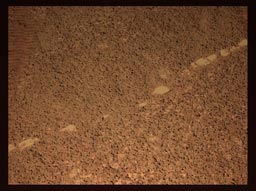
Monte Cristo
Opportunity took this picture of the vein Monte Cristo in early June with her panoramic camera. It wasn't exactly the vein the robot field geologist was looking for, so she drove on to Grasberg, a large flat slab of bedrock at the norther end of Cape York, along the rim of Endeavour Crater. Stuart Atkinson processed it here in color.NASA-JPL/Cornell/S. Atkinson
Opportunity began the month of June checking out a geologic vein that the team members dubbed Monte Cristo, one of many veins in the Bench or apron like area bordering Cape York. The scientists believe they all contain gypsum, like the vein called Homestake, which the robot field geologist roved across and studied last December. That's a big scientific deal.
The discovery of gypsum is one of the most significant scientific findings on the MER mission. "This tells a slam-dunk story that water flowed through underground fractures in the rock," Squyres said back when he announced the discovery at the fall American Geophysical Union (AGU) meeting in December 2011.
Both Opportunity and twin Spirit found evidence of past water during their primary 90-day mission. However – with the exception of Spirit's discovery of carbonate in a rock near the bottom of Husband Hill in Gusev Crater – the evidence for other past aqueous environments pointed to water more akin to acid rain than what comes out of our taps.
Gypsum is a strong clue that "a kinder, gentler chemistry" was at work in the water that flowed through the ancient rocks at Cape York, and it may have offered an environment more conducive to the emergence of life. The MER scientists believe the past water environment there could have supported microbial life.
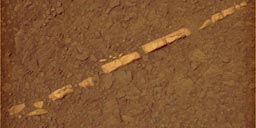
Homestake
Opportunity took this picture of Homestake, the striking vein running through bedrock in December 2011, and Stuart Atkinson processed it here in rich color. "This is different than anything we've ever seen with either rover," MER PI Steve Squyres told the MER Update before discovering that Homestake is harboring gypsum. It was one of the biggest discoveries Opportunity has made to date.NASA /JPL-Caltech/Cornell/S. Atkinson
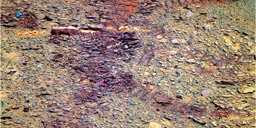
Homestake Crunched
After checking out Homestake in December 2011, Opportunity was instructed to perform a "triple crunch," as Deputy PI Ray Arvidson called it. "We backed over the vein, drove forward, then turned in place and left. We crunched it," he said. It turned out to be filled with "sparkly bits." Stuart Atkinson processed the image here in "retina burning false color." The vein contains a lot of gypsum, evidenced of past flowing water – and that provided the MER scientists with one of their most important discoveries on the mission to date.NASA/JPL- Caltech/Cornell/S. Atkinson
Since Opportunity had to hunker down for winter, there wasn't enough time to do a detailed study of Homestake, and that was okay. The scientists really needed the rover to find a wider vein to dig into, if it was really going to be able to examine the interior of these veins with its composition detecting instruments.
With winter's passing and power rising, Opportunity headed out on that mission in May, and as June dawned at Meridiani Planum, it seemed like the rover might have found just the right vein in Monte Cristo. "It looked very much like Homestake," said Squyres. "Unfortunately, we were unable to RAT it, because it's surface configuration was not right."
That's when "[t]hings became complicated," according to a JPL mission report. On June 7th (Pacific time, June 8th Universal Time), one of Odyssey's reaction wheels stuck for a few minutes, sending the orbiter into safe mode and out of data relay service for Opportunity.
Odyssey uses a set of three reaction wheels to control its attitude – or which way it is facing relative to the Sun, Earth or Mars. Increasing the rotation rate of a reaction wheel causes the spacecraft itself to rotate in the opposite direction. The configuration in use from launch until this event combined the effects of three wheels at right angles to each other to provide control in all directions.
"For myself, there was a 'gulp' when I heard that one of Odyssey reaction wheels was getting faulty," said Keuneke. "Unlike other safeing events I'd seen Odyssey go into before, this one really worried me, because the reaction wheels are how the orbiter stabilizes in orbit."
There was more trouble to come.
Later that same afternoon, Opportunity's uplink to the Mars Reconnaissance Orbiter (MRO) on an already scheduled (UHF) relay pass didn't make it. It was not a good sol on Mars.
"We didn't know why MRO had not received any data from us," recounted Bill Nelson, chief of the rover engineering team at JPL. "A 'bad link' was pretty high on the probability list, but we could not at that time rule out some fault on Opportunity that would have prevented it from transmitting. So the next Martian day, we promptly did one of our contingency direct-to-Earth passes and did some special commanding that showed the rover was responding."
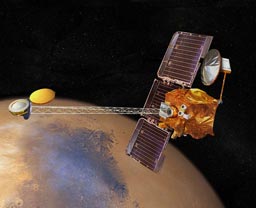
Mars Odyssey
Mars Odyssey, which has worked at Mars longer than any other mission, is the main data relay link for Opportunity and an unsung "hero" among Mars spacecraft. When the orbiter went into safe mode in June, the Mars Exploration Rover mission was slowed, but it didn't stop Opportunity from roving. The orbiter, which had suffered the loss of one of its three operational reaction wheels, was reconfigured to use its spare wheel and was back in service June 27th.NASA/JPL-Caltech
As it turns out, the missed MRO pass was the result of what they call "poor relay geometry." In other words, the orbiter was orbiting Mars close to the horizon, instead of overhead, said Nelson. "When the orbiter is so low in the sky, it's difficult to communicate, especially at the high data rates," he said.
The team subsequently requested that MRO and Opportunity transmit data at the slowest rate of 32 kilobits per second, and the data came through without issue. "That was the last of our MRO passes for a while," Nelson said, "but we knew Opportunity was fine."
Odyssey's event, however, was going to take longer to resolve, and it would impact the MER mission throughout much of June. "The Odyssey safeing event slowed us down in that we had to be more restricted in when we could plan mobility," said Townsend. "Typically we get the data down in a day or two so we have the information to plan the next activity. But in this case, with Odyssey being out of service, we weren’t getting the data we needed to plan that next movement until five days later. That limited the number of operations we could do," she explained.
Redundancy rules in planetary exploration missions, and it saved the day and the orbiter in the case of Odyssey. Built in and waiting – skewed at angles to all three other reaction wheels – is a fourth, spare wheel, designed and positioned to be a replacement for any one of the three operating reactions wheels. When the Odyssey engineers concluded that the sticking reaction wheel was unreliable, they switched the orbiter from that one to the unused spare.
Odyssey does have thrusters it can use for attitude control, but they draw on the spacecraft's limited supply of propellant instead of than electricity generated from the orbiter's solar array. Fuel is precious and this unsung hero among Mars spacecraft has a docket full of responsibilities. Beyond its own science mission and serving as the primary MER relay link, Odyssey will also be serving as Curiosity's back-up relay link. Obviously, the reaction wheels are critical to the orbiter being able to carry out all those assignments.
Although Odyssey was brought out of safe mode on June 16th, the orbiter was put through a sequence of tests and activities to attain full recovery, which kept it out of service for another week and a half.
Opportunity and the MER team persevered with a handful of MRO passes and their already scheduled direct-to-Earth (DTE) and direct-from-Earth (DFE) communiqués. "We've been using DTEs, and periodically some MRO passes, and even had a Mars Express demo pass that did return data," reported Nelson.
Since the direct communications, where the rover downlinks or uplinks data direct to the Deep Space Network on Earth via its X-band, can only carry limited amounts of data, the pace slowed. Nevertheless, together, rover and crew mustered through the month and proceeded to get an admirable amount of science work done in spite of it all.
The unplanned respite and easy, breezy month rendered an important reminder. "This last month proved how much we rely on Odyssey," said Keuneke.
"I firmly believe that the relay data we've gotten from Odyssey, Mars Global Surveyor, and MRO has made it possible for MER to live as long as we have," added Townsend, who has been with the mission since development days. "If we would have had to get all our data back from DTE links, then we wouldn't have been able to do nearly as much with the limited power we get at certain times."

Mars
The fourth "rock" from the Sun, Mars is rusty reddish in color, and was named after the Roman god of war. Mars orbits the Sun every 687 Earth days, so a Martian day or "sol" is about half an hour longer than Earth. At its brightest, the Red Planet outshines every other planet except Venus.NASA
Despite the communications breakdown, Opportunity still managed to actually do a little driving and in mid-June, the rover headed further north along the geologic bench that borders Cape York North looking for another target. "We aligned our drives so that the pictures and critical data from the drive would come down on the two scheduled MRO passes we had each week," Nelson said.
The rover generally kept on a slight slope as much as possible to take in the Sun, even as the winds of the Martian spring continued to clear more dust from her solar arrays and boost her power levels.
Thanks to the spare wheel that had been waiting 11 years to be put to use, Odyssey was back in action Wednesday, June 27th. The orbiter immediately picked up data from Opportunity and then got back to its own scientific observations of Mars, and completing preparations to serve as a communications relay for Curiosity, aka Mars Science Laboratory (MSL).
"Odyssey is now back in full, nominal operation mode using the replacement wheel," Steve Sanders, lead engineer for the Odyssey team at Lockheed Martin Space Systems, Denver, stated in a NASA/JPL press announcement. [Lockheed collaborates with JPL in operation of the orbiter.]
Down on Earth, in the halls of MER, the data stored onboard Opportunity for a good part of June began streaming in. "We do have a big backlog of data on the spacecraft and until we get it out, we're probably going to be reluctant to drive," said Nelson. Right now, there's work to complete at Cape York – and the team is not rushing anywhere.
With the skies above and Opportunity's solar arrays clearing, it likely won't be long before the rover heads back to the south. In any case, she's picking up the pace.
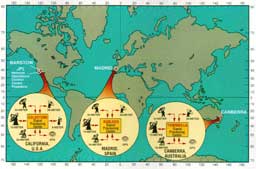
Deep Space Network
The Deep Space Network (DSN), which is managed by NASA's Jet Propulsion Laboratory (JPL), features three sites disseminated in key areas of the world – Spain, Australia, and California. And it isn't enough. Dozens of space missions sprinkled around the solar system must compete for the undivided attention of the few antennas capable of communicating with their spacecraft. This map shows the locations of the three DSN signal processing centers and indicates the number and type of antennas at each site.NASA
As June gives way to July, the rover is positioned over a large flat rock called Grasberg and is scheduled to grind in to it and see what's inside. With her newfound robust power levels, anyone who's followed this mission knows that this rover is raring to go.
"Now that Odyssey is back online and the power is good, we should be able to really start cranking," said Squyres, who'd just emerged from 12 days in the Other Frontier, aboard the underwater habitat Aquarius, as part of the NEEMO 16 crew. [Squyres is among the scientists and researchers performing field tests on Earth to prepare for the challenge of exploring destinations in space – and maybe even someday . . . going to Mars.]
So when will Opportunity drive on? "We'll be driving on when we're ready," said Squyres.
On July 2nd, Opportunity will quietly guide her team and MER followers everywhere into Sol 3000, the 3,000th Martian day of exploration on an expedition that was originally slated for 90 days. "Unbelievable," mused Squyres.
The action begins on at about 6:50 am Pacific time (13:50 UTC), informed Nelson.
"We would have thought we would have been very lucky to make it over a year," Townsend said, reflecting on the early days of the mission. "Even when we made it through that first winter – and then got that first cleaning on Spirit that made us very excited because it meant we could live longer – we never thought it would be multiple years. We thought maybe we could make me to the next winter if we were really, really lucky."
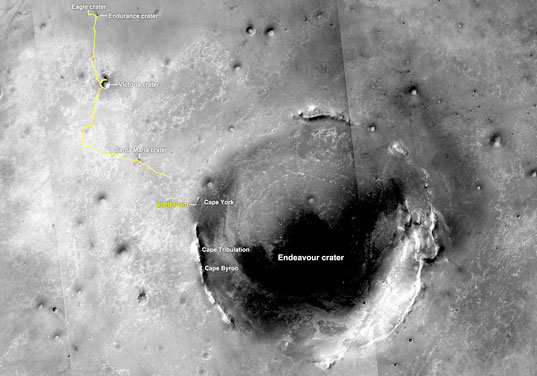
Path to Endeavour
The yellow line on this map shows the route Opportunity has taken from Eagle Crater, where the robot field geologist landed in January 2004, at the upper left end of the track, to a point about 3.5 kilometers (2.2 miles) away from the rim of Endeavour Crater. The rover arrived at the 22- kilometer (14-mile) diameter hole in the ground in August 2011, after a three-year journey from Victoria Crater.NASA/JPL-Caltech/MSSS
The MER mission has roved for so long now it seems to be something of a miracle on Mars. With every new milestone, every new discovery, and every new Martian sol, it only becomes more remarkable. What more is there to say?
"Nothing," said Squyres. "Except it's really cool – and we're still going."
Opportunity from Meridiani Planum
Opportunity drove out of May on her Sol 2969 (May 31, 2012), heading to the northeast for 36 feet (11 meters) in search of a vein she could dig into. The rover was producing an ample amount of power of around 366 watt-hours, but the operations team was still somewhat concerned and was continuing to direct Opportunity to keep her arrays generally angled to the north. "The attitude was to take it slow and find more of veins," said Keuneke.
As the first week of June got underway, the rover drove 2.3 meters (7.54 feet) on Sol 2971 (June 2, 2012) to place a choice vein, dubbed Monte Cristo, within the work volume of her instrument deployment device (IDD) or robotic arm. Taking advantage of the 3-sol weekend plan, Opportunity conducted an atmospheric argon measurement the following sol with her Alpha Particle X-ray Spectrometer (APXS),
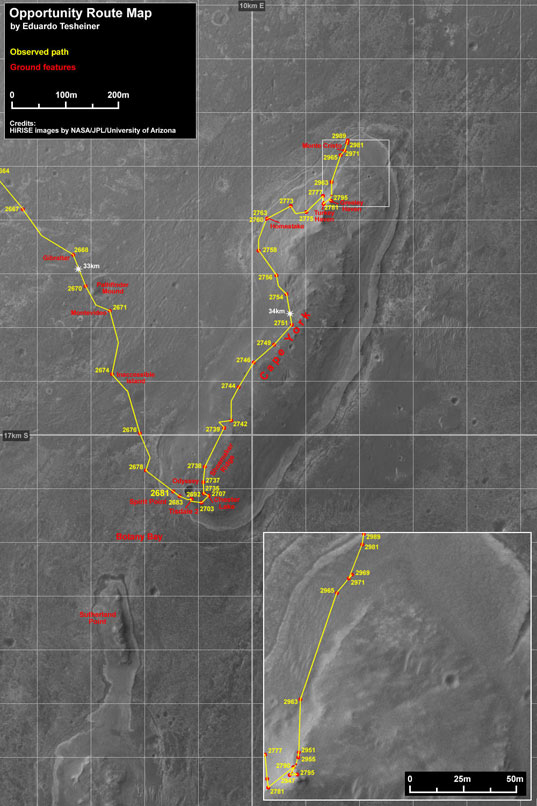
Opportunity route map
This route map shows Opportunity's travels up to its Sol 2989 (June 20, 2011), the rover's approximate current location at the northern end of at Cape York. It was produced by Eduardo Tesheiner, of UnmannedSpaceflight.com, who created it from images taken by cameras onboard the Mars Reconnaissance Orbiter. The rover, which officially reached the rim of Endeavour Crater rim on Aug. 9, 2011, settled into a parked position on a north-facing slope Dec. 26, 2011 for its fifth Martian winter. After four and a half months of working from a solitary position, the rover roved on.NASA/JPL-Caltech/UA/MSSS/E.Tesheiner
Then, on Sol 2974 (June 5, 2012), the robot field geologist began the in-situ or contact investigation of Monte Cristo. She began by taking a series of close-up pictures of an exposed portion of the vein with her Microscopic Imager (MI) mosaic. Opportunity then placed the APXS for a multi-sol integration to determine its composition.
The plan had been for Opportunity to dig into the vein, but that was not to be. "It had a sort of concave surface to it and we couldn't RAT the thing, so we had to go off in search of something else," said Squyres.
Less than a sol later, one of Odyssey's three operational reaction wheels stuck for a few minutes tripping a fault, sending the spacecraft into safe mode. Since the orbiter uses the reaction wheels stabilize itself in orbit, this was a serious safeing event.
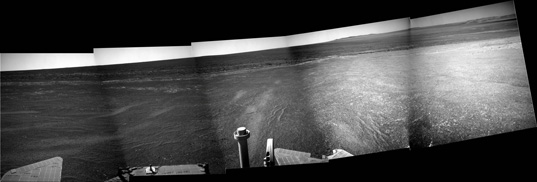
Field of veins
Opportunity strolled through a field of veins in June, looking for a good target to dig into. A vein called Monte Cristo looked promising, but in the end the rover moved on to another assignment. Eduardo Tesheiner created this mosaic from the component images the rover sent home late in May 2012. It shows the rover's view ahead.NASA/JPL-Caltech/Cornell/E. Tesheiner
"A reaction wheel has its effect not because it's spinning, but because the spin rate changes, Nelson noted. "The torque on a non-symmetrical spacecraft is a small one, because of the solar wind is a small, but it’s a continuous one. To counteract it, you have to slowly but continuously speed up the corresponding reaction wheel that damps out that torque. The reaction wheel speeds up and speeds up until it gets to a predetermined limit." There is a limit, because if the wheel spins too fast and goes on for too long, it will burst apart under the centrifugal forces.
Because of this, the Odyssey crew periodically conducts a de-saturation or desat procedure where they slow down the reaction wheel. " When you slow it down, you're generating another torque in the opposite direction," Nelson pointed out. "And so as part of the desat, you spin down the reaction wheel, bring its velocity down, but you have to counteract the torque it causes by firing the thruster. What happened with Odyssey was they were seeing what they call sticktion in the reaction wheel. In other words, it was not smoothly changing torque. They were getting these torque spikes, high friction, in there, which meant wheel wasn't operating properly. It tripped their fault protection, which killed their sequence, and that sequence was supporting Opportunity's relay operations," he explained.
While the Odyssey team worked to get their spacecraft back in service, the MER operations team regrouped and waited for data to come down from MRO. "We were actually scheduled to do an MRO pass the same day," said Nelson. "We uplinked to MRO using the high data rate 256 kilobits per second."
But – nothing showed up. Not good. Opportunity's operations team began to get concerned. "We knew that Odyssey had just gone into safeing and we were afraid that what happened with MRO may mean something bad for us as well," Nelson said.
It turned out this was a low elevation pass and the link just would not support that high of a data rate. So MRO simply didn't get any data. "But we didn't know that at the time," said Nelson.
The next day, Sol 2977 (June 8, 2012), the MER engineers responded to the missed UHF pass by sending real-time commands direct-from-Earth to Opportunity on Sol 2977 (June 8, 2012), to elicit a direct-to-Earth response to make sure the rover was okay.
Opportunity phoned home. The rover was under sequence control. "Normally a bad fault will kill all sequences and put you under flight software control. It's sort of like having one of your applications crash and that app is then terminated and you go back to running under your operating system," explained Nelson. "In our case, flight software is our operating system and the sequences are like our applications. Since the applications were still running, it meant that we had not had a serious crash on the vehicle. That was a good sign," he said. The engineers were beginning to suspect that the missed relay pass was simply the result of poor relay geometry between the orbiter and rover.
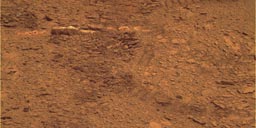
Homestake Revisited
This image of Homestake, which Opportunity took with her Pancam back in December 2011, was processed here in rich Martian color by Stuart Atkinson. It shows the "sparkly bits" that Deputy Principal Investigator Ray Arvidson talked about in previous MER Updates. The scientists found that Homestake is rich with gypsum, a sure sign of past water in this area of Mars. See more of Atkinson's work.NASA/JPL-Caltech/Cornell/S. Atkinson
The MER team asked MRO to change the data rate on the next relay pass, slated for later that same sol, to ensure lock-up under poor signal-to-noise conditions. We did that on the theory that a low data rate with a high probability of success was preferable to the intermediate 128-kilobits-per-second rate which would have provided more data," Nelson offered. Opportunity then uplinked data to the orbiter at the 32-kilobit-per-second rate.
Down on Earth, the MER team soon received what they wanted. "We got enough data to prove we were healthy and confirm we were in good shape. Opportunity was just fine," Nelson confirmed.
"MRO was low on the horizon with a peak elevation of maybe 12.5 degrees over the horizon, with directly overhead being 90 degrees and that was just too low to support a high data rate," said Nelson. "Frankly, we should not have used that high of a data rate. That was a mistake on our part. It as originally scheduled to be 256-kilobit data rate, because [when the pass was scheduled] nobody knew where MRO would be at the time – and we should have dropped it tactically." The engineers shortly thereafter determined that the 128-kilobit rate would be "supportable for most passes" with MRO for the time being.
As the second week of June began, Opportunity's power levels rose to hover around 388 watt-hours, as the Tau or atmospheric opacity, registering 0.338, continued to improve. The rover's solar array dust factor improved slightly to 0.567.
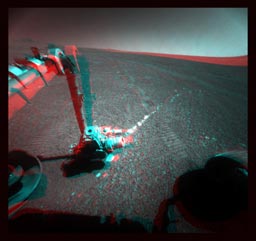
Opportunity at Monte Cristo 3D
Get your blue-red glasses and check out this 3D image of Opportunity checking out the vein called Monte Cristo, courtesy Stuart Stkinson. See more of Atkinson's workNASA/JPL-Caltech/Cornell/S. Atkinson
Knowing Odyssey would be unavailable for relay support for a while and that they had limited access to MRO, the MER project converted several future rover Deep Space Network tracking passes from direct-from-Earth to direct-to-Earth and commanded Opportunity to return at least some telemetry directly over her X-band system. In other words, they used already scheduled transmissions to downlink data from Mars, rather than just uplinking commands from Earth.
"When Odyssey went into safeing – except for the occasional MRO passes – we had no other way of downlinking data, so all of our passes involved sending data back on X-band, the DTEs," said Nelson. "On Sol 2988, for example, we had no DSN track scheduled for that day, and so we simply didn't get any data that day. But we worked to downlink as much data as possible on X-band. And the MRO UHF passes – we typically get two a week – helped tremendously."
Opportunity's work schedule lightened to hanging out and a modest campaign of mostly taking a lot of pictures with her Pancam and other onboard cameras. But there's not much that's ever been able to keep Opportunity down. With the combination of limited MRO relays and the use of DTE X-band passes, the MER team found a way for the rover to rove on.
On Sol 2981 (June 12, 2012), Opportunity drove 17 meters (a little more than 56 feet) to the north, approaching the boundary between the Cape York geologic unit and the Meridiani plains. The following sol, Mars seemed to urge the rover on, sending dust gusters to clear most of the rusty red powder from her arrays, giving her another significant bump in power. And the robot field geologist worked in an atmospheric argon measurement.
During the third week of June, as Opportunity was making the best of things by taking pictures, Odyssey resumed pointing downward toward Mars on Saturday, June 16, leaving the Earth-pointed "safe mode" status triggered the reaction wheel stuck. "Attitude control in nadir pointing is being maintained with the use of the replacement wheel, and the suspect wheel has been taken out of use," Odyssey Project Manager Gaylon McSmith of JPL, stated in a NASA-JPL press release.
While Odyssey's controllers continued characterizing the performance of the replacement wheel while assessing other activities of the spacecraft, Opportunity conducted another routine atmospheric argon measurement on Sol 2987 (June 18, 2012), with her APXS, and took more pictures.
Then, on Sol 2989 (June 20, 2012), Opportunity took a short jaunt of 5.8 meters (19.02 feet) to the north, to straddle the boundary unit between Cape York and the Meridiani Plains. The rover then looked for a candidate target within the work volume of the robotic arm.
Opportunity, which now had 34.49 kilometers (21.43 miles) on her odometer, continued to benefit from dust gusters, and her power greatly increased the daily energy production. By the time the third week of June came to an end, the rover was producing 526 watt-hours. The Tau had dropped to 0.229 and the solar array dust factor improved significantly to 0.684.
"We had enough energy to do what we needed to do and then we got probably more energy than we actually needed, but that extra energy we can level the rover out and park on less favorable slopes from the Sun standpoint," Keuneke said. "This broadens our flexibility."
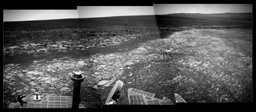
The view ahead
Opportunity took a series of pictures that finally streamed down to Earth and Stuart Atkinson "stitched" them together to create this mosaic panorama that showed her view looking to the north around mid-June. The hills in the distance define the northern rim of Endeavour Crater.NASA/JPL-Caltech/Cornell/S. Atkinson
During the past week, the numbers just kept getting better. "By Sol 2993 (June 25, 2012) we had 549 watt-hours, and the dust factor was .724, which is quite astonishing," said Keuneke. On that sol, the rover pulled out her RAT and got to business, brushing a target area along the boundary line.
Two sols later, Odyssey was back in service, allowing the MER team, as well as the Odyssey team, to breathe a sigh of relief. "It was a relatively healthy pass from a data volume standpoint. Very good news!" reported Keuneke, just hours after the team had received the data on Wednesday, June 27th.
"I was looking at this with wider eyes than other events [on Odyssey], because I personally knew this was a pretty dangerous safeing event," Keuneke said. "If you lost reaction wheel control, then you're probably getting close to the end of the mission. I was very eager to see that they had a mitigation, that redundant wheel that can keep them working. But I definitely had a gulp moment."
The data came streaming in none too soon. "We were down to 475 megabits [of storage] onboard Opportunity," said Nelson. "Since we're trying to maintain a floor of about 300 megabits, that left about 150 megabits to play with. And that's not even enough to do a good drive and all the imaging it needs to do after a drive."
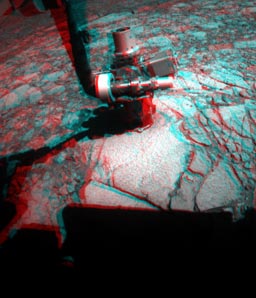
Opportunity at Grasberg in 3D
Put you blue-red glasses on to immerse yourself in this 3D image of Opportunity at Grasberg, processed in 3D by Stuart Atkinson. The rover spent the last weekend in June examining this flat rock and even pulled used her Rock Abrasion Tool (RAT) to dig in.NASA/JPL-Caltech/Cornell/S. Atkinson
Contemplating the worst of scenarios in Odyssey's near future isn't something anyone involved in a Mars mission right now wants to do. But what if –? What's the back-up plan for Opportunity?
"We can send data through MRO, though we don't currently have very regular MRO passes, and we don't have the kind of long-standing relationship as we do with Odyssey which we've had since the very beginning of our mission," said Townsend. "Of course, we do have a relationship with MRO and have been working with them for some time now. But MRO joined us as a relay when we were deep into the mission, so we don't have the team we had in the primary mission to create and build tools and things to support our use of this new resource."
The MER operations team doesn't have quite as good an understanding of the data they expect to come down on a given pass from MRO. "With Odyssey, we can predict how much data we'll get back from a certain pass to within 10 megabits," said Townsend. "With MRO, there's more guesswork of how much data we'll get back on a certain pass. It just has to do with how our UHF antenna pattern with their UHF antenna pattern and how they're pointed and etcetera, etcetera, etcetera."
This time, of course, the worst didn’t happen. But this is Mars and the adage that anything can happen anytime is magnified. "If anything happened to Odyssey, it would be a huge concern," admitted Townsend. Certainly, it would strain the resources for both rovers. Curiosity and Opportunity would have to compete for more limited resources as far as relay communication. "In the end, I think both rovers would suffer as a result just from having less access to relay data," she said.
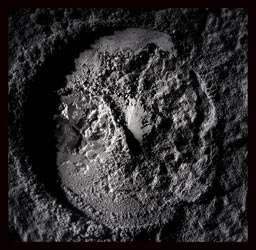
Grasberg post RAT
This image, courtesy Stu Atkinson, shows the freshly RAT-ed surface of Grasberg. The robot field geologist pulled out her rock abrasion tool (RAT) at the end of June and went to work, promptly return the images as Odyssey, its main data relay link, which went back into service June 27th, after being out of commission for most of the month.NASA/JPL-Caltech/S. Atkinson
"The two big items were the cleaning events, and the Odyssey safeing and losing our relay asset for much of the month, so we did stumble a little bit in June, to no fault of Opportunity's," said Keuneke. "But it also shows we have quite a bit of resilience and can deal with adverse situations when presented with them. So I think things went very well considering."
Obviously the team is happy and relieved that Odyssey is back online. "Now we can do more intense scientific activity because the Sun is back, the arrays are clean, and we're ready to go," said Keuneke. Now that "things are worked out," he added, "we can get back to full speed and that's what's happening as we speak."
It's something to take advantage of, for sure. Curiosity – the new bigger, faster, bigger rover – is slated to land August 5, 2012 Pacific Time, a little more than four weeks away, and Opportunity will have to put on the brakes again. "We will have a command moratorium, which means we will not try to talk to our rover or use the X-band during the EDL," informed Nelson. He means, actually, about a week, because that moratorium will encompass the incoming TCM [trajectory correction maneuver] period, and the actual EDL. "During that time, we will have Odyssey passes – the rationale being that our daily pass proves Odyssey is still available for MSL," he confirmed.
Once Curiosity is landed, Opportunity will have to share her Odyssey relay time.
Thus, Curiosity will have exclusive use of MRO, and more than half of Odyssey. The writing on that wall would seem to indicate that the rover that likes to rove may find it slow going again from time to time during MSL's prime mission of one Earth year.
As July heats up on Mars and on Earth, Opportunity is digging into a large flat rock called Grasberg, named after a goldmine in Indonesia. No, there's no gold there. But one of the rover's science goals in this area is to do a good characterization of the boundary area between Cape York and the plains. "That's really the goal we're working on now," said Townsend. "Well leave when the scientists are ready."
And so, as the MER mission prepares to pass the Sol 3000 milestone, Opportunity will be working away, tending to finishing up the science business at the north end of Cape York.
Author's Note
I first went to Mars when I was 11 years old. Ray Bradbury took me.
Those nights, snuggled in a wingback chair, the soft glow from a small lamp lighting the pages of The Martian Chronicles in the darkness of my bedroom, remain among the fondest of my childhood. Doors to new perceptions opened on those nights as I read about a dusty red, alien world... a future time of fantastical possibilities with people who seemed just like us. Rocketing on his words, I was transported, and my life, my world – I – was changed. I was a Martian... walking alongside Timothy and his family.

Ray Bradbury
This picture of Ray Bradbury served as the author photo for many of his books and appears on his website, RayBradbury.com.Tom Victor
That I wound up "chronicling" the adventures of the Mars Exploration Rovers decades later is, I know, because of Ray Bradbury. That I would spend much of my career as a science journalist seeking out people with new ideas, new thoughts and theories, new experience, is no coincidence either. I got a taste early. Ray Bradbury was not only imaginative; he was an original thinker. He could see things that didn't exist and know they should or would, and put them into the human consciousness decades before the world could catch up.
His death on June 5th took me by surprise. I swear I felt "a great disturbance in the Force, as if millions of voices suddenly cried out"* – in silent sadness.
Ray is my favorite author always, and he was a dear friend, adviser, and supporter of The Planetary Society. We knew he had been ill over these last few years. And yet I expected he would live to 100. Why? I don't know.
I do know that there are some people who come into your life, lift your soul, and stay forever. For me, Ray is one of those people. At least one of his books – yes books – goes with me every time I travel. We shared a love for the smell of the "stacks" at the old L.A. Library. Multiple editions of The Martian Chronicles, Dandelion Wine, and Fahrenheit 451, along with collections like A Medicine for Melancholy, The Illustrated Man, and all the others, many well worn, command an entire shelf in my living room. I cannot even imagine my life without his stories, his profound allegories, his magical way of weaving words, and the treasured moments over the years, lucky me, of talking with and corresponding with the master storyteller.
When Scott Maxwell, Ashley Stroupe, Steve Squyres, John Callas, Frank Hartman and John Wright of the MER team made it possible for Ray to drive on Mars during the 5th anniversary celebration of the mission at JPL – something he'd actually never done on Earth – it was another convergence. [See Scott Maxwell's blog]
Clearly, I am not alone in my mad love for Ray Bradbury. So many people in the planetary science community and beyond have also been teleported to Mars by the landscapes and people and times he painted in words. And so, there is only one way to end this edition of the MER Update. With his words.
. . . The night came down around them, and there were stars. But Timothy couldn't find Earth. It had already set. That was something to think about.
A night bird called them among the ruins as they walked. Dad said, "Your mother and I will try to teach you. Perhaps we'll fail. I hope not. We've had a good lot to see and learn from. We planned this trip years ago, before you were born. Even if there hadn't been a war we would have come to Mars, I think, to live and form our own standard of living. It would have been another century before Mars would have been poisoned by the Earth civilization. Now of course –"
They reached the canal. It was long and straight and cool and wet and reflective in the night.
"I've always wanted to see a Martian said Michael. "Where are they Dad, you promised."
"There they are," said Dad, and he shifted Michael on his shoulder and pointed straight down.
The Martians were there. Timothy began to shiver.
The Martians were there – in the canal – reflected in the water.
Timothy and Michael and Robert and Mom and Dad.
The Martians stared back up at them for a long, long silent time
from the rippling water...
Excerpt from The Martian Chronicles ("The Million Year Picnic")
© Copyright 1946, 1948, 1949, 1950, 1958, renewed 1977 by Ray Bradbury
* Acknowledgment to George Lucas
The Time is Now.
As a Planetary Defender, you’re part of our mission to decrease the risk of Earth being hit by an asteroid or comet.
Donate Today

 Explore Worlds
Explore Worlds Find Life
Find Life Defend Earth
Defend Earth


